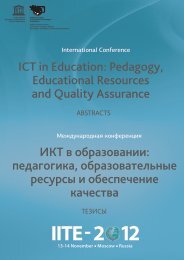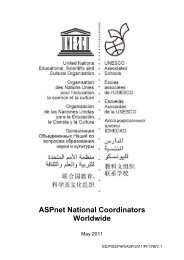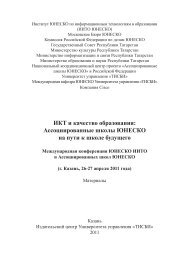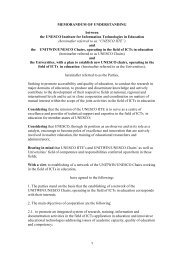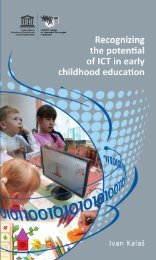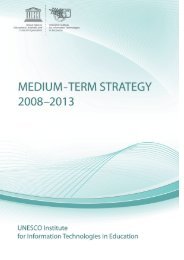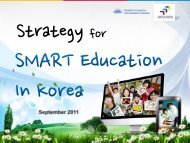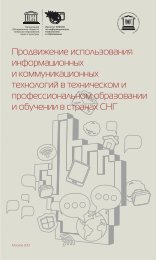UNESCO ICT Competency Framework for Teachers ... - unesco iite
UNESCO ICT Competency Framework for Teachers ... - unesco iite
UNESCO ICT Competency Framework for Teachers ... - unesco iite
You also want an ePaper? Increase the reach of your titles
YUMPU automatically turns print PDFs into web optimized ePapers that Google loves.
<strong>UNESCO</strong> <strong>ICT</strong> <strong>Competency</strong> <strong>Framework</strong> <strong>for</strong> <strong>Teachers</strong><br />
48<br />
MODULE 2<br />
APPENDIX 2: EXAMPLE SYLLABI AND EXAM SPECIFICATIONS<br />
TECHNOLOGY LITERACY<br />
2.3 GIVEN A SCENARIO, EVALUATE AND SELECT AN <strong>ICT</strong> ASSESSMENT<br />
RESOURCE<br />
SCOPING STATEMENT<br />
Scope, cost considerations, classroom<br />
dynamics; <strong>for</strong>mative vs. summative<br />
approaches; includes <strong>for</strong>mative and<br />
summative assessment, such as:<br />
an online exam<br />
students demonstrating what they have<br />
learnt (e.g. putting together a video<br />
or creating a spreadsheet, making a<br />
presentation to the class)<br />
evaluating the teaching (students clicking<br />
their answers to a question displayed on a<br />
presentation software screen.<br />
TASK COMPONENTS<br />
Analyze the scenario to determine what<br />
needs to be assessed and the available<br />
resources or tools.<br />
Determine what type of assessment is<br />
needed, <strong>for</strong> example summative or <strong>for</strong>mative<br />
assessments, and including assessments<br />
in which students do something practical<br />
rather than taking a written test.<br />
Identify and evaluate <strong>ICT</strong> assessment<br />
resources, <strong>for</strong> example Survey Monkey.<br />
Match <strong>ICT</strong> resources to assessment.<br />
Consider diff erent types of online assessment<br />
(multiple choice, fi lling the blanks, matching,<br />
drag and drop etc.).<br />
OUT OF SCOPE<br />
Test theory. Attendance records, classroom<br />
management issues (they belong in<br />
section 5).<br />
TASK FREQUENCY, IMPORTANCE, DIFFICULTY<br />
AND OCCURRENCE<br />
Weekly, very important, diffi cult and this task<br />
is scheduled or planned <strong>for</strong>.<br />
PREREQUISITE KNOWLEDGE<br />
Basic knowledge of assessment methods in<br />
teaching.<br />
Awareness of advantages of <strong>ICT</strong>-based<br />
assessment, <strong>for</strong> example that it can provide<br />
instant feedback, automated scoring,<br />
automated data-collection and item analysis.<br />
BEST PRACTICES<br />
Exploiting the potential of <strong>ICT</strong> to provide<br />
more frequent, accurate, and detailed<br />
in<strong>for</strong>mation than can be achieved with<br />
conventional assessment.<br />
OBSTACLES<br />
Lack of resources, <strong>for</strong> example only one<br />
computer so class cannot do an online test.<br />
COMMON MISTAKES<br />
Over-reliance on statistical data, which<br />
becomes more readily available using <strong>ICT</strong> but<br />
extra data and statistics do not necessarily<br />
constitute extra in<strong>for</strong>mation.<br />
Assumption that <strong>ICT</strong>-based assessment<br />
means an online test, rather than, say, making<br />
a video to demonstrate what you have learnt.<br />
Spending a disproportionate amount of time<br />
creating an <strong>ICT</strong> <strong>for</strong>m of assessment when a<br />
simpler <strong>for</strong>m would be satisfactory.<br />
CRITICAL MISTAKES<br />
Allowing <strong>ICT</strong> to distort assessment methods<br />
or aims.<br />
SUCCESS CRITERIA<br />
Know how to proceed with the teaching<br />
(whether to move on or re-teach), how to<br />
advise students, how to amend teaching,<br />
revise an activity or resources.





